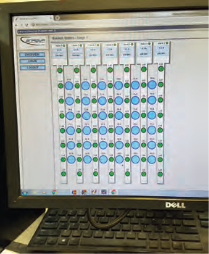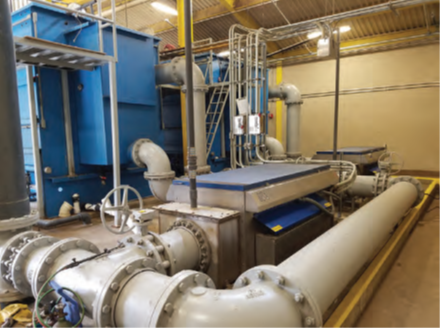
Ken Harwood, assistant foreman, checks the lamp racks in the noncontact UV disinfection unit.
REVIEWING OPTIONS
In summer 2011, the town retained a consulting engineer to investigate and recommend a new UV disinfection system. Decision factors included:
• Capital cost including ancillary equipment
• Energy and maintenance costs
• Ability to meet the coliform permit limits (200 cfu/100 mL) withoutchemicals
• Fit within the existing system footprint and facility hydraulic profile
• Ease of operation and interface with the plant SCADA system
After the consultant interviewed three UV system manufacturers, thetown selected the noncontact system. Water flows through activated fluoropolymer tubes (AFP840) surrounded by the UV lamps. Each tube is exposed to UV light from all sides. Velocity within each tube produces a scouring effect that prevents solids deposition in the tubes. There are no quartz sleeves to clean.
Two noncontact UV units were commissioned in 2013; only one unit needs to be online at any given time. After six months of continuous service, the town operations staff found significant reductions in operating costs.
COUNTING BENEFITS
The original system consumed 315,360 kWh per year at a cost of $50,458; the news system consumed 77,088 kWh per year at a cost of $12,334, a savings of $38,124 or 75%. Costs also decreased for parts (from $23,000 per year to $2,330) and maintenance labor (from $31,200 to $90). As a result, the non-contact UV disinfection system showed a full payback on the investment after 1.8 years of operation, based on a capital cost of $166,000 and annual power, parts, and labor savings of $89,904.
The noncontact UV disinfection system continuously meets permit requirements. The two reactors fit the existing building and allotted space. It required no significant piping modifications and in fact simplified the piping.
The Ayer Wastewater Treatment Plant staff is committed to reducing the use of chemicals wherever possible, as less chemical addition for disinfection means less going into the environment. UV disinfection has proven to be a viable way to move away from chemicals. The noncontact UV disinfection system has produced tangible savings in plant operations while reducing the financial burden to ratepayers.

A control room display shows the status of the UV reactor.
Ayer Wastewater Plant
Noncontact UV Brings Savings
A replacement UV Disinfection System cuts costs for energy, parts, and maintenance labor at Massachusetts Clean-Water Plant
By Kenneth Harwood and Thomas G. Valorose
A 2007 expansion of the Town of Ayer (Massachusetts) Wastewater Treatment Plant included UV disinfection to replace gaseous chlorine, eliminating safety concerns and significantly reducing chemical and operation and maintenance costs.
Soon afterward, plant personnel observed that the UV units were not robust enough to meet the NPDES permit limits for coliform. To avoid permit violations, the plant had to supplement the UV process with the addition of chemicals.
Rather than continue under that scenario, the plant team investigated alternative UV disinfection systems, and in 2014 it installed a noncontact UV system in which water flows through transparent tubes and UV lamps surround each tube in a dry environment. The system has produced substantial savings in power costs, parts and labor, and total cost of ownership.
CORRECTIVE ACTION
The Town of Ayer’s activated sludge treatment plant (1.8 mgd design, 1.4 mgd average) serves a population of 8,100 in Middlesex County. The 2007 expansion included new anoxic tanks and tertiary filters for TSS removal in addition to the UV disinfection units.
Previously, disinfection was accomplished by the addition of chlorine gas, followed by dechlorination with sodium bisulfite before discharge to the Nashua River. When the original UV system failed to meet the facility’s needs, the plant team supplemented it by overdosing with sodium hypochlorite to ensure complete disinfection and permit compliance. This led to chemical costs and to energy consumption beyond the power required for the UV units.
The original disinfection system was a flanged, in-line system between two isolation valves with disinfection lamps perpendicularly inserted into the flow stream. Each lamp was encased in a quartz sleeve for protection and to allow UV light to pass. The sleeves needed regular cleaning and replacement. The lamps, lamp seals, ballasts and other components also needed replacing; the town had to keep a large inventory of spares on hand.
In addition, operators found the UV system difficult to maintain and keep clean. To perform routine maintenance and repair, it had to be drained and taken offline, during which time chemical disinfection was necessary.

In the noncontact UV system, water flows through transparent tubes and UV lamps surround each tube in a dry environment.

The dual UV reactors fit into an existing building space and required no significant piping modifications.
ABOUT THE AUTHORS
Kenneth Harwood is an assistant foreman with the Town of Ayer (Massachusetts) Wastewater Treatment Plant.
Thomas G. Valorose (tvalorose@r-r-inc.com) is a sales engineer with Russell Resources, a manufacturer’s representative firm in East Greenwich, Rhode Island.
Source: TPO (Treatment Plant Operator) Magazine - March 2020
REVIEWING OPTIONS
In summer 2011, the town retained a consulting engineer to investigate and recommend a new UV disinfection system. Decision factors included:
• Capital cost including ancillary equipment
• Energy and maintenance costs
• Ability to meet the coliform permit limits (200 cfu/100 mL) withoutchemicals
• Fit within the existing system footprint and facility hydraulic profile
• Ease of operation and interface with the plant SCADA system
After the consultant interviewed three UV system manufacturers, thetown selected the noncontact system. Water flows through activated fluoropolymer tubes (AFP840) surrounded by the UV lamps. Each tube is exposed to UV light from all sides. Velocity within each tube produces a scouring effect that prevents solids deposition in the tubes. There are no quartz sleeves to clean.
Two noncontact UV units were commissioned in 2013; only one unit needs to be online at any given time. After six months of continuous service, the town operations staff found significant reductions in operating costs.
COUNTING BENEFITS
The original system consumed 315,360 kWh per year at a cost of $50,458; the news system consumed 77,088 kWh per year at a cost of $12,334, a savings of $38,124 or 75%. Costs also decreased for parts (from $23,000 per year to $2,330) and maintenance labor (from $31,200 to $90). As a result, the non-contact UV disinfection system showed a full payback on the investment after 1.8 years of operation, based on a capital cost of $166,000 and annual power, parts, and labor savings of $89,904.
The noncontact UV disinfection system continuously meets permit requirements. The two reactors fit the existing building and allotted space. It required no significant piping modifications and in fact simplified the piping.
The Ayer Wastewater Treatment Plant staff is committed to reducing the use of chemicals wherever possible, as less chemical addition for disinfection means less going into the environment. UV disinfection has proven to be a viable way to move away from chemicals. The noncontact UV disinfection system has produced tangible savings in plant operations while reducing the financial burden to ratepayers.

A control room display shows the status of the UV reactor.
A 2007 expansion of the Town of Ayer (Massachusetts) Wastewater Treatment Plant included UV disinfection to replace gaseous chlorine, eliminating safety concerns and significantly reducing chemical and operation and maintenance costs.
Soon afterward, plant personnel observed that the UV units were not robust enough to meet the NPDES permit limits for coliform. To avoid permit violations, the plant had to supplement the UV process with the addition of chemicals.
Rather than continue under that scenario, the plant team investigated alternative UV disinfection systems, and in 2014 it installed a noncontact UV system in which water flows through transparent tubes and UV lamps surround each tube in a dry environment. The system has produced substantial savings in power costs, parts and labor, and total cost of ownership.
CORRECTIVE ACTION
The Town of Ayer’s activated sludge treatment plant (1.8 mgd design, 1.4 mgd average) serves a population of 8,100 in Middlesex County. The 2007 expansion included new anoxic tanks and tertiary filters for TSS removal in addition to the UV disinfection units.
Previously, disinfection was accomplished by the addition of chlorine gas, followed by dechlorination with sodium bisulfite before discharge to the Nashua River. When the original UV system failed to meet the facility’s needs, the plant team supplemented it by overdosing with sodium hypochlorite to ensure complete disinfection and permit compliance. This led to chemical costs and to energy consumption beyond the power required for the UV units.
The original disinfection system was a flanged, in-line system between two isolation valves with disinfection lamps perpendicularly inserted into the flow stream. Each lamp was encased in a quartz sleeve for protection and to allow UV light to pass. The sleeves needed regular cleaning and replacement. The lamps, lamp seals, ballasts and other components also needed replacing; the town had to keep a large inventory of spares on hand.
In addition, operators found the UV system difficult to maintain and keep clean. To perform routine maintenance and repair, it had to be drained and taken offline, during which time chemical disinfection was necessary.

In the noncontact UV system, water flows through transparent tubes and UV lamps surround each tube in a dry environment.

The dual UV reactors fit into an existing building space and required no significant piping modifications.

Ken Harwood, assistant foreman, checks the lamp racks in the noncontact UV disinfection unit.
Ayer Wastewater Plant
Noncontact UV Brings Savings
A replacement UV Disinfection System cuts costs for energy, parts, and maintenance labor at Massachusetts Clean-Water Plant
By Kenneth Harwood and Thomas G. Valorose
ABOUT THE AUTHORS
Kenneth Harwood is an assistant foreman with the Town of Ayer (Massachusetts) Wastewater Treatment Plant.
Thomas G. Valorose (tvalorose@r-r-inc.com) is a sales engineer with Russell Resources, a manufacturer’s representative firm in East Greenwich, Rhode Island.
Source: TPO (Treatment Plant Operator) Magazine - March 2020

![[Website] Enaqua-Logo_40th.png](https://static.wixstatic.com/media/9f8950_2da47d0be3a3410cbbf6abf20ab3696c~mv2.png)
.png)